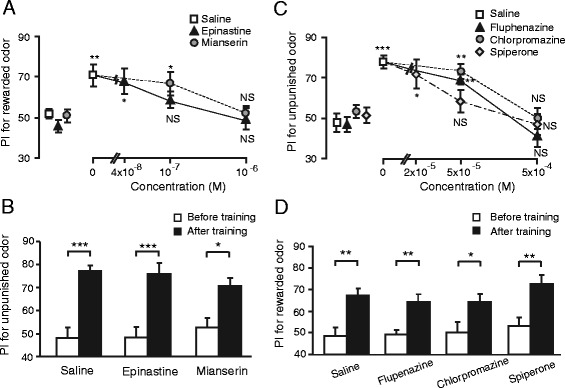Figure 3.

Effects of OA or DA receptor antagonists on appetitive and aversive olfactory conditioning. (A) Dose-dependent effects of OA receptor antagonists on appetitive olfactory conditioning. Six groups of crickets were injected with 3 μl saline (white squares) or saline containing 0.04 μM, 0.1 μM or 1 μM epinastine (black triangles) or 0.1 μM or 1 μM mianserin (gray circles). (B) Effects of OA receptor antagonists on aversive olfactory conditioning. Three groups of crickets were injected with 3 μl saline or saline containing 1 μM epinastine or 1 μM mianserin 30 min before 6-trial aversive conditioning. (C) Dose-dependent effects of DA receptor antagonists on aversive olfactory conditioning. Eight groups of crickets were injected with 3 μl saline (white squares) or saline containing 50 μM or 500 μM fluphenazine (black triangles), 50 μM or 500 μM chlorpromazine (gray circles) or 20 μM, 50 μM or 500 μM spiperone (white diamonds). (D) Effects of DA receptor antagonists on appetitive olfactory conditioning. Four groups of crickets were injected with 3 μl saline or saline containing 500 μM fluphenazine, 500 μM chlorpromazine or 500 μM spiperone 30 min before 2-trial aversive conditioning. Relative odor preferences were measured as preference indexes (PIs) for rewarded odor (A, D) or unpunished control odor (B, C) before (data points at the left) and at 30 min after conditioning (data points at the right) and are shown with means ± SEM. The results of statistical comparison before and after conditioning are shown as asterisks (Wilcoxon’s test, *P < 0.05; **P < 0.01; ***P < 0.001, NS P < 0.05). Modified from Unoki et al. [7].
